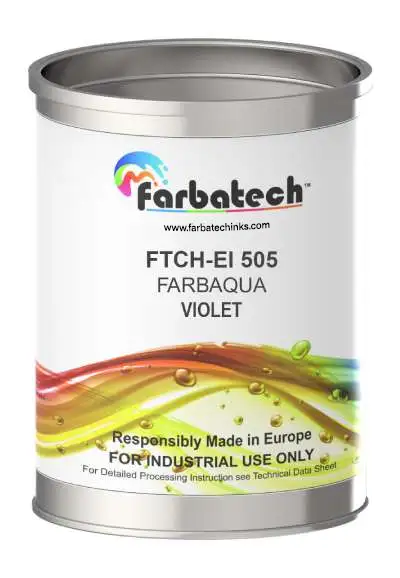
What are water-based inks?
Water-based inks are environmentally friendly paint/ ink that use water as the ink vehicle. This kind of ink has low volatile organic compounds. These inks mainly contain two components i.e. water, resins, and pigment or color. Thereby, they provide a sustainable coating for printing.
Farbaqua: Farbatech’s water-based inks
Farbaqua is a water-based pad/screen printing ink by Farbatech. This is a medium glossy and opaque ink. It is suitable for applying on substrates such as-
- ABS
- PVC
- PC
- Pre-Treated PP
- Wood
- Coated Substrates
The use of Farbaqua consists of single and multi color printing, particularly on toys and the sports industry. As ecologically sound inks, Farbaqua inks are PAH and Halogen-free. The VOC content in these inks is much lower < 10% as compared to those of other solvent-based inks> 40%. Pigments of medium to high fade resistance are used for Farbaqua inks. These inks are medium-fast drying. After proper and thorough drying, the ink film exhibits outstanding adhesion as well as a rub, scratch, and block resistance.
To avoid damage, Farbaqua inks must never be stored or transported at temperatures below 5°C . When stored at a temperature range of 15–25°C, the shelf life of the unopened ink container is 1 year.
Perks of Farbaqua inks that we swear by
FARBAQUA combat solvent-based inks easily. Listed below are the features of Farbaqua inks that we swear by
- Environmentally-friendly
- Minimal discharge of toxins
- Reduced carbon footprint
- PAH and Halogen free.
- Low volatile organic compounds (VOCs)
- Use of sustainable raw materials
- Cuts on incinerator costs
- Increased pot life
- High fade resistance
- Good adhesion
- Lightweight
- Soft hand
- Mechanical and chemical resistance
- Scratch resistance
How can water-based inks bring a change?
When are proud of our water-based inks for a reason. An attribute that causes utmost concern is the vehicle used in a sustainable ink. The driving force of water-based inks isthat it causes its minimal or least destruction to the environment. After intense research we have created this water ink without compromising on its quality. Using water-based inks is cost-effective today and a helps to create a sustainable future.
Our brilliantly tailor-made Farbaqua ink is applicable on substrates like wood (coated or uncoated), ABS, PVC, and PC. These inks are suited for applications compliant with the toys directive DIN EN 71-3. They are, made without the use of BPA/BPS. Hence, these inks are more environment-friendly and safety compliant.
Sectors, where water-based inks can do wonders, include-
- Apparels
- FMCG
- Toys
- Baby products
- Sports
- Garments
- Medical
- Flexible Packaging
- Corrugated Containers
- Labels
- Folding Cartons
- Beverages (Metal Cans)
- Cosmetics
Frequently Asked Questions
The comparison between water-based and solvent-based inks is a hot topic. One needs to understand that both of these inks have their merits and demerits. Thereby, only the substrate or the application can help you determine which is better. Nevertheless, a few differences that draw a line between the two are as follows-
- Solvent-based inks exhibit great adhesion while water-based inks are naturally sound.
- The raw materials we require for solvent-based inks are available easily.
- The operational cost of water-based inks is less.
- Water-based inks have low VOC while solvent-based inks reflect high-print quality.
- Typically, if the application requires slower printing speeds on an absorbent surface, needs to follow environmental regulations, and compliances, depending upon the demand of the water-based inks are a preferred choice.
We can use water-based inks for substrates such as-
- ABS
- PVC
- PC
- Pre-Treated PP
- Wood
- Coated Substrates
Further, the industries that use water-based inks are-
- Apparels
- FMCG
- Toys
- Baby products
- Sports
- Garments
- Medical
- Flexible Packaging
- Corrugated Containers
- Labels
- Folding Cartons
- Beverages (Metal Cans)
- Cosmetics






